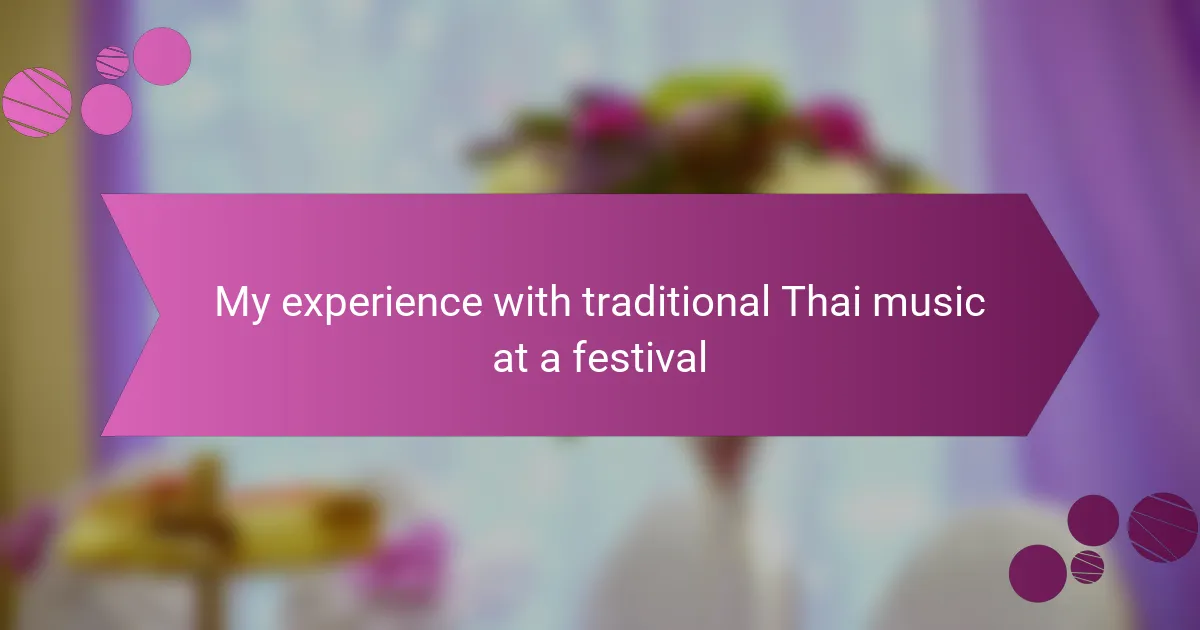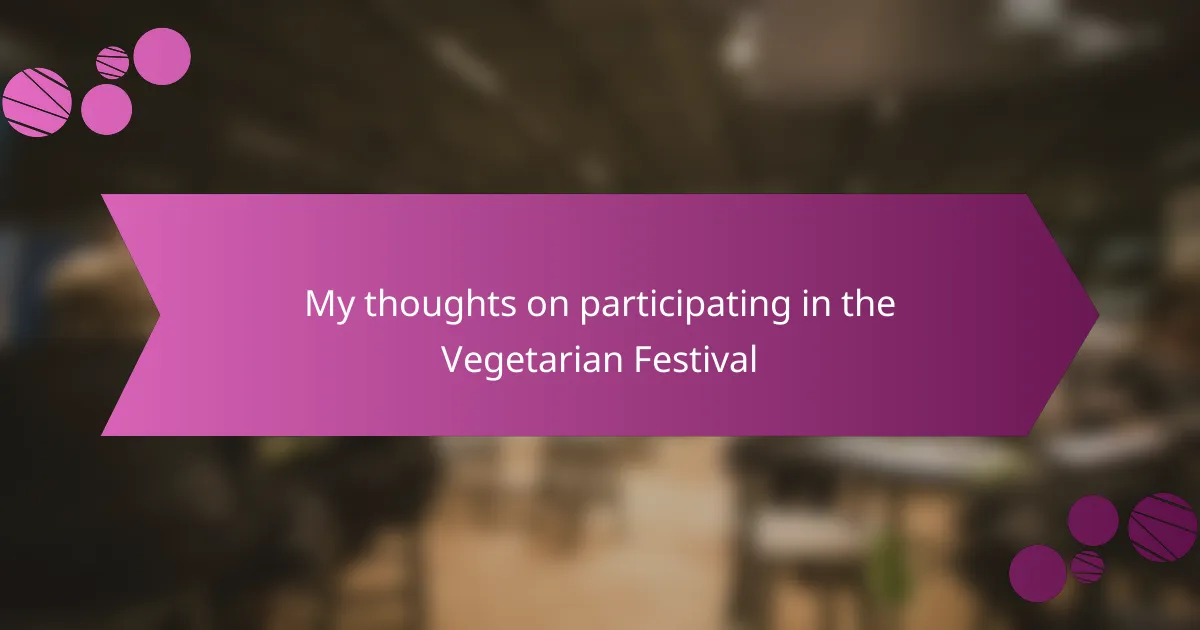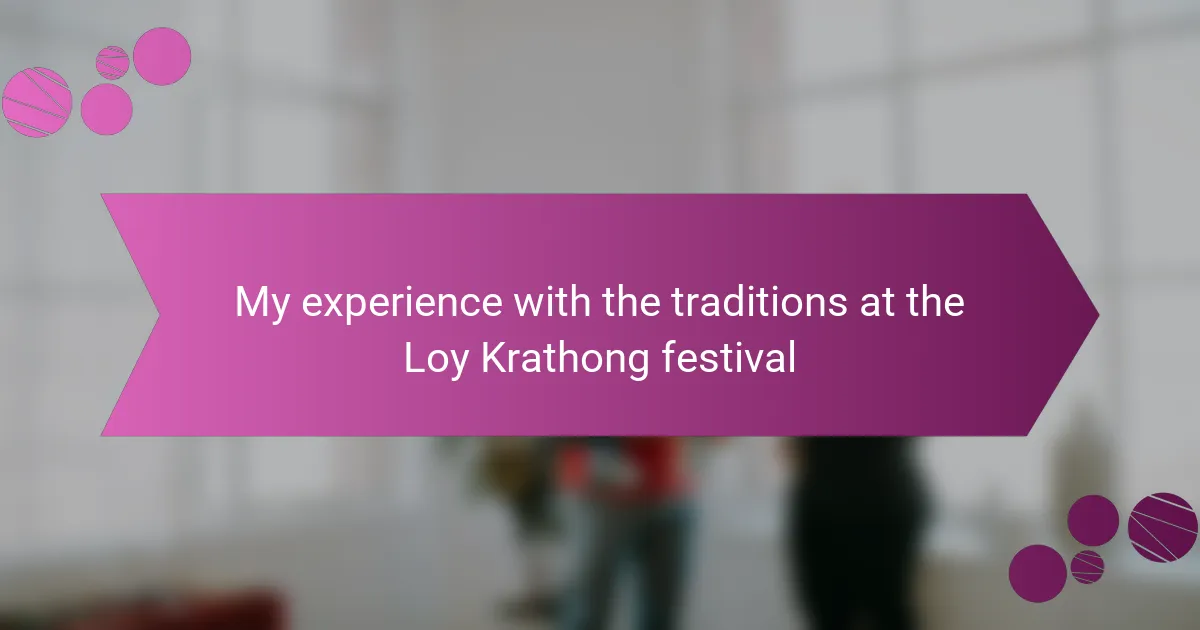Key takeaways
- Thai music festivals celebrate cultural heritage through diverse musical styles, engaging performances, and delicious local cuisine.
- Traditional Thai music fosters unity, emotional expression, and educational value, preserving stories and historical events.
- Key instruments like the ranad, khim, and mor lam create captivating sounds that evoke deep emotional connections among audiences.
- Festival experiences offer immersive atmospheres, allowing attendees to connect with Thai culture and enjoy interactive performances.
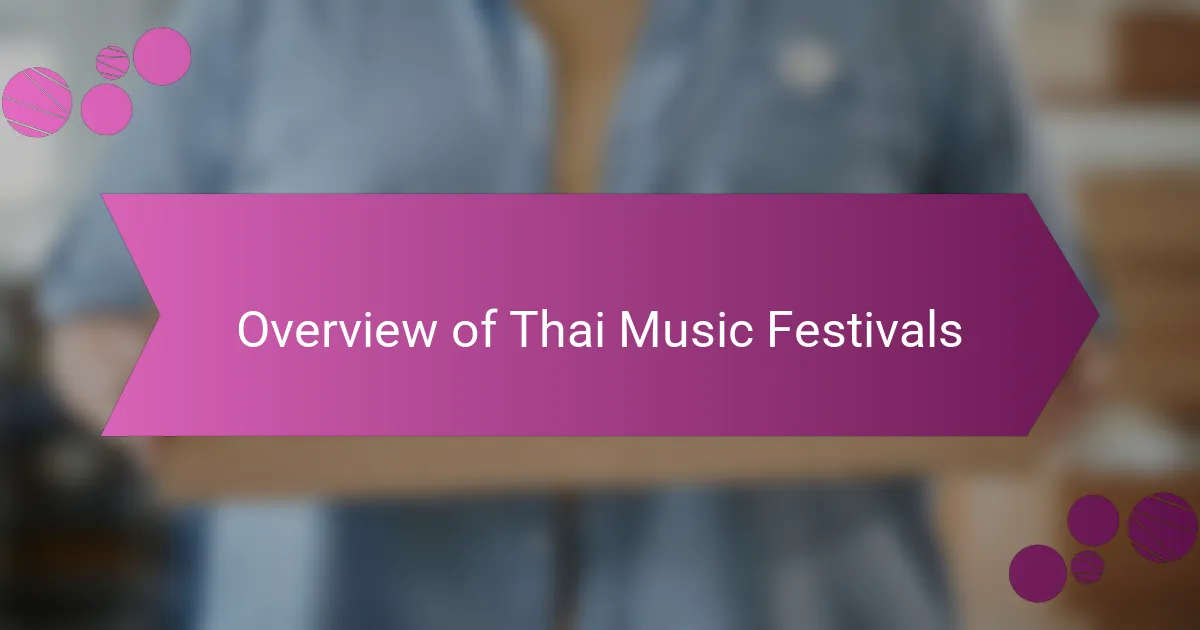
Overview of Thai music festivals
Thai music festivals are vibrant celebrations that showcase the country’s rich cultural heritage. I remember my first festival; the energy in the air was palpable, filled with colorful decorations and the rhythmic beat of traditional instruments. These festivals not only bring together talented musicians but also foster a sense of community, where people from all walks of life come together to appreciate the beauty of Thai music.
What I found fascinating during my experience was how each festival has its unique flavor, often centered around different themes or regions of Thailand. Attendees enjoy a variety of performances, from classical ensembles to folk music, all while indulging in delicious local cuisine. Here are some noteworthy aspects of Thai music festivals:
- Diverse musical styles ranging from classical to contemporary
- Engaging activities, including workshops and dance performances
- Delicious street food vendors offering local delicacies
- Opportunities to connect with local artisans and musicians
- An inviting atmosphere that promotes cultural exchange and unity
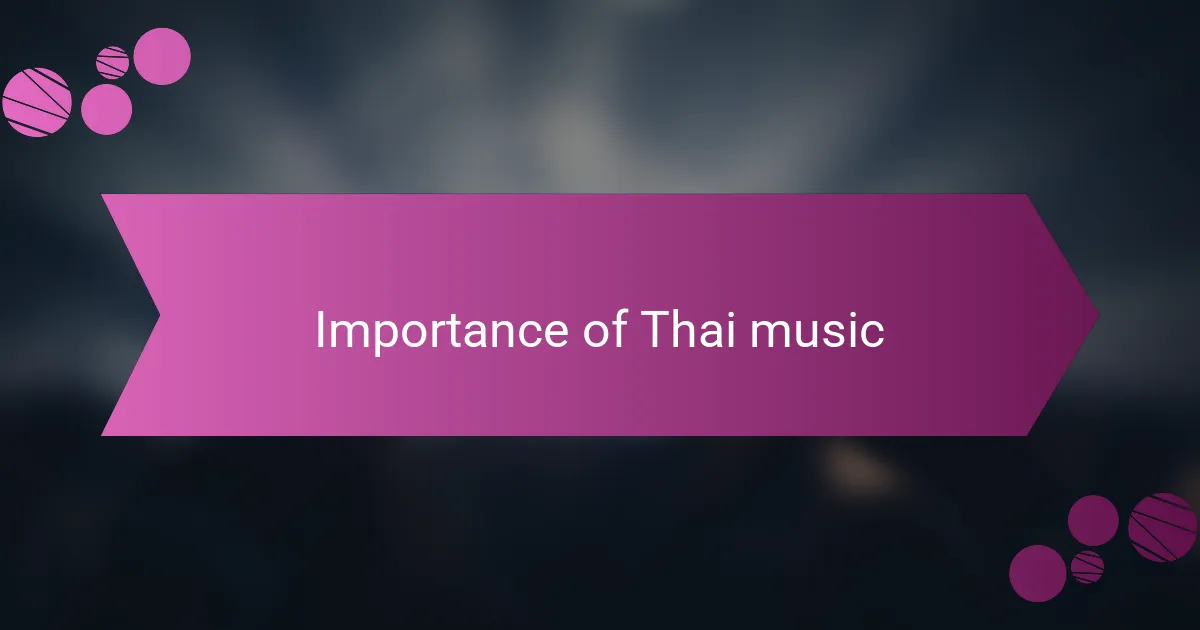
Importance of Thai music
Thai music holds significant importance as it serves as a cultural tapestry, weaving together the nation’s history, traditions, and communal identity. I vividly remember standing amidst a crowd at a vibrant festival where the traditional sounds resonated in my heart, creating a deep connection with the people around me. This communal experience not only entertained but also educated me about the rich stories behind each note and rhythm.
The essence of Thai music lies in its ability to evoke emotions, foster unity, and preserve heritage. When I heard the enchanting melodies of the ranad (a traditional bamboo xylophone), I felt a sense of nostalgia, as if the music was telling stories of love and joy that transcended generations.
- Cultural Preservation: Thai music safeguards age-old traditions, ensuring that they are passed down through generations.
- Emotional Expression: The melodies often reflect deep feelings, allowing listeners to connect personally to the stories being shared.
- Community Bonding: Festivals where Thai music is featured encourage social interactions, helping foster a sense of community and shared identity.
- Educational Value: Traditional music serves as a medium through which stories and historical events can be learned and appreciated.
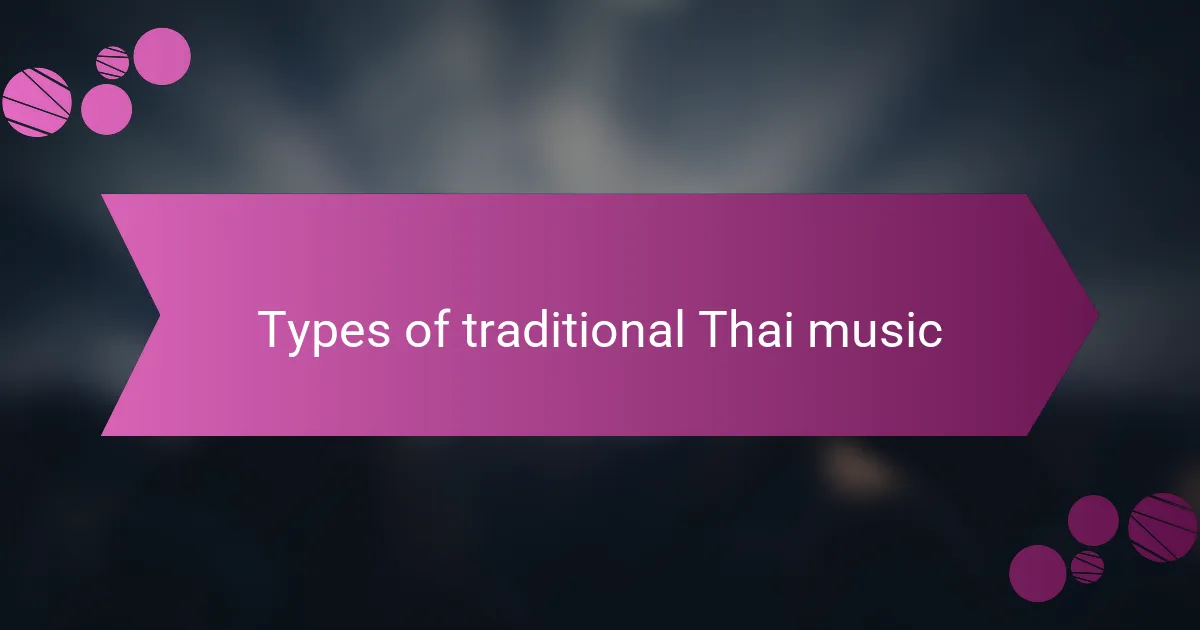
Types of traditional Thai music
Exploring the types of traditional Thai music is like taking a journey through the heart of Thailand. I remember attending a festival where I was captivated by the enchanting sounds of Khim and Ranat, two string instruments that evoke deep emotions. The melodies they produce seem to carry stories whispered through generations.
At the same festival, I experienced the lively rhythms of Mor Lam, a distinct folk music style from Northeastern Thailand. It’s engaging and invites everyone to dance. I found myself swaying to the beat, feeling a sense of connection with those around me that transcended language.
Here’s a quick comparison of some notable types of traditional Thai music:
| Type of Music | Description |
|---|---|
| Khim | A traditional stringed instrument creating soft and melodic tunes. |
| Ranat | A wooden xylophone with vibrant sounds, often used in classical performances. |
| Mor Lam | Folk music characterized by lively rhythms, encouraging audience interaction. |
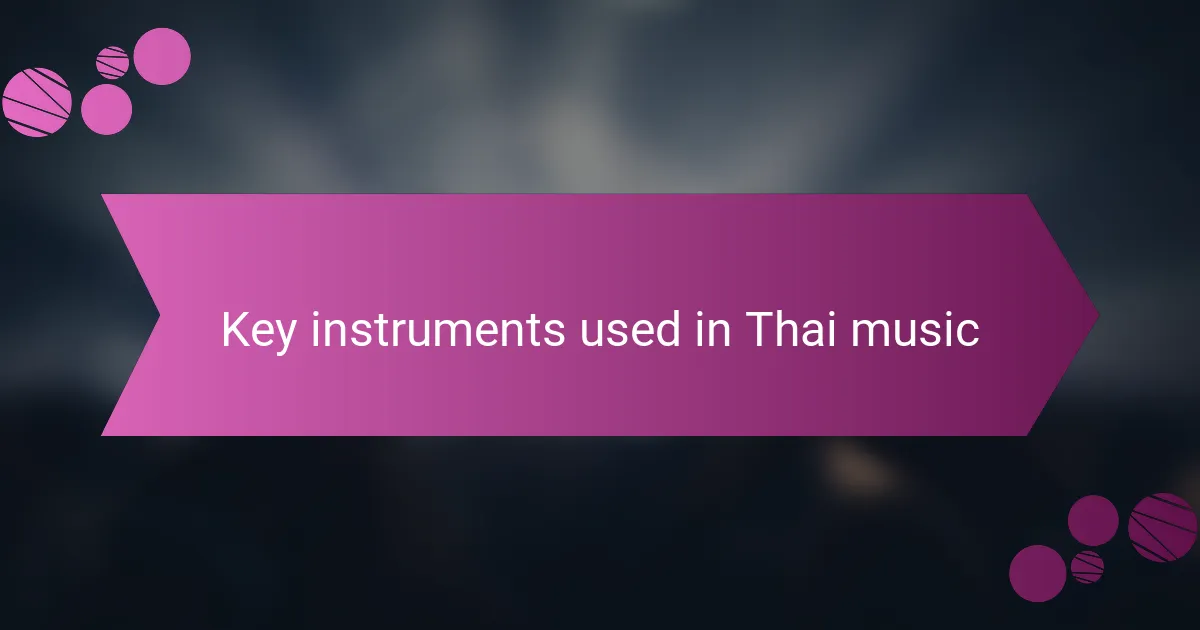
Key instruments used in Thai music
In traditional Thai music, several key instruments stand out, each contributing its own unique flavor. The ranad ek, a striking wooden xylophone, produces lively rhythms that can instantly uplift spirits. I remember how its bright tones resonated throughout the festival, creating an inviting atmosphere where everyone felt the urge to dance.
Another fascinating instrument is the chao khan, which is a kind of two-stringed lute. I found its soothing melodies remarkably calming, as if they were echoing serene moments of nature. Listening to it, I couldn’t help but wonder how many emotions had been expressed through its strings over the years.
Perhaps one of the most captivating instruments is the khlui, a traditional bamboo flute known for its mellow sound. I recall a moment when a skilled musician played a hauntingly beautiful tune that seemed to pause time. The breathy notes carried stories and memories, making me appreciate the depth of connection that music can forge among us. Each note stirs a sense of nostalgia, inviting listeners on a journey through Thailand’s rich cultural history.

My first experience at the festival
Attending my first traditional Thai music festival was an unforgettable experience. I was immediately drawn in by the vibrant colors of the decorations and the sounds of live traditional instruments like the khim and ranat. It felt enchanting to see performers dressed in traditional costumes, as they brought the music to life with graceful movements.
As the evening progressed, I found myself completely immersed in the atmosphere. The melodius charm of the music resonated within me, creating a sense of connection to Thai culture that I hadn’t felt before. I remember chatting with locals who shared stories about the significance of different songs and instruments, enhancing my understanding and appreciation of the art form.
My emotions fluctuated between excitement and awe as I experienced the rich heritage of Thailand through its music. It was a beautiful reminder of how music can transcend language barriers and bring people together.
| Aspect | Experience |
|---|---|
| Atmosphere | Vibrant and lively, filled with colors and sounds |
| Instruments | Live performances featuring khim and ranat |
| Connection | Felt a deep cultural connection through storytelling |

Highlights of the festival performances
The performances at the festival were nothing short of enchanting. Sitting in the front row, I felt the surge of energy as skilled musicians played traditional instruments like the khim and the ranat. Each note seemed to tell a story, immersing me in the rich cultural tapestry of Thailand.
One highlight was when I witnessed a mesmerizing dance accompanied by live music. The performers, clad in vibrant costumes, moved gracefully to the rhythm, and it felt like time stood still. I couldn’t help but smile as I joined the crowd in clapping along, completely captivated by their artistry.
- Live performances from acclaimed musicians and local talents.
- Traditional dance interpretations that beautifully showcased Thai culture.
- Interactive sessions where festival-goers could try out instruments.
- Illuminating workshops explaining the history and significance of Thai music.
- A blend of modern and traditional sounds, providing a fresh take on classic pieces.
